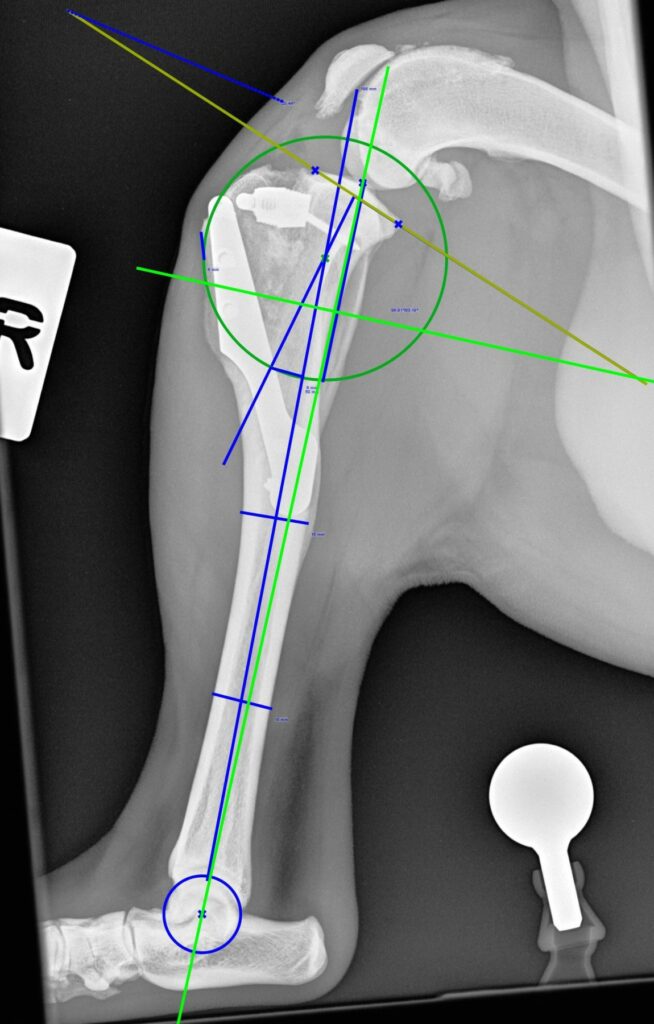
Hnízdo J. Řešení komplikace po TTA pomocí dvojí osteotomie: DFO a CORA-based TPLO. Treatment of TTA complication with double osteotomy: DFO and CORA-based TPLO. Veterinářství 2018;68(10):686-694.
SOUHRN
Kazuistika prezentuje případ tříletého samce pitbula, který byl referován kvůli sekundární luxaci pately a výrazné reziduální kraniální instabilitě po předešlé TTA operaci. Z důvodů umístění klícky z první operace byla pro stabilizaci kloubu zvolena nově popsaná metoda CORA based TPLO (cb-TPLO). Současně byla mediální luxace pately řešená distální femorální osteotomií (DFO). Článek popisuje metodiku stanovení CORA proximálního procurvatum tibie a samotné provedení této nové metody alterující geometrii v CCL deficitním kolenním kloubu. DFO byla provedena standardně jako closing wedge osteotomie z laterální strany a stabilizována anatomickou DFO ploténkou. Cb-TPLO byla stabilizována dlouhou přemosťovací ploténkou mediálně a kratší ploténkou kraniálně. Rekonvalescence pacienta byla nekomplikovaná. V diskusi autor srovnává stávající techniky TPLO a CBLO s metodou cb-TPLO aplikovanou v tomto případě. Hlavní rozdíl je shledáván v metodice stanovení anatomické osy tibie při cb- TPLO ve srovnání s technikou CBLO. Samotnou metodu lze dobře standardizovat a aplikovat v případech, kdy je umístění implantátů v proximální metafýze tibie nemožné, jako v případě implantátů z předešlé chirurgie nebo u juvenilních pacientů s otevřenými růstovými ploténkami.
SUMMARY
Hnízdo J. Treatment of TTA complication with double osteotomy: DFO and CORA-based TPLO. Veterinářství 2018;68(10):
This paper describes the case of a three-year-old male pitbull terrier, which was presented for a secondary grade III patella luxation and significant residual cranial instability after previous TTA surgery. Due to the placement of the cage from previous operation, CORA based TPLO (cb-TPLO) was chosen to stabilize the joint. At the same time, medial patella luxation was addressed with distal femoral osteotomy (DFO). The article describes the methodology of determining the CORA of proximal tibial procurvatum and implementation of this alternative geometry altering surgical method in the treatment CCL deficient knee joint. DFO was performed as a standard closing wedge osteotomy from lateral side and stabilized by an anatomical DFO locking plate. Cb-TPLO was stabilized with a long bridging locking plate and 3.5 mm screws medially and a shorter orthogonal locking plate and 2.5 mm screws applied cranially. The recovery of the patient was uncomplicated. In the discussion, the author compares the current TPLO and CBLO techniques with the new cb-TPLO method applied in this case. The main difference is found in the methodology of determination of the anatomical axis of the tibia with cb-TPLO compared to the CBLO technique. The method itself is well standardized and applicable in cases, where implants in proximal tibial metaphysis make TPLO impossible, as in the case of implants from previous surgery. Cb-TPLO may also be well applied in juvenile patients with cruciate ligament surgery and open growth plates.*